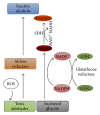Molecular mechanisms of diabetic retinopathy, general preventive strategies, and novel therapeutic targets
- PMID: 25105142
- PMCID: PMC4106080
- DOI: 10.1155/2014/801269
Molecular mechanisms of diabetic retinopathy, general preventive strategies, and novel therapeutic targets
Abstract
The growing number of people with diabetes worldwide suggests that diabetic retinopathy (DR) and diabetic macular edema (DME) will continue to be sight threatening factors. The pathogenesis of diabetic retinopathy is a widespread cause of visual impairment in the world and a range of hyperglycemia-linked pathways have been implicated in the initiation and progression of this condition. Despite understanding the polyol pathway flux, activation of protein kinase C (KPC) isoforms, increased hexosamine pathway flux, and increased advanced glycation end-product (AGE) formation, pathogenic mechanisms underlying diabetes induced vision loss are not fully understood. The purpose of this paper is to review molecular mechanisms that regulate cell survival and apoptosis of retinal cells and discuss new and exciting therapeutic targets with comparison to the old and inefficient preventive strategies. This review highlights the recent advancements in understanding hyperglycemia-induced biochemical and molecular alterations, systemic metabolic factors, and aberrant activation of signaling cascades that ultimately lead to activation of a number of transcription factors causing functional and structural damage to retinal cells. It also reviews the established interventions and emerging molecular targets to avert diabetic retinopathy and its associated risk factors.
Figures




References
-
- International Diabetes Federation. Facts and figures, http://www.idf.org/worlddiabetesday/toolkit/gp/facts-figures.
-
- Pirart J. Diabetes mellitus and its degenerative complications: a prospective study of 4,400 patients observed between 1947 and 1973 ( Pt 1) Diabetes Care. 1978;1(3):168–188.
-
- Nguyen QD, Shah SM, Khwaja AA, et al. Two-year outcomes of the ranibizumab for edema of the mAcula in diabetes (READ-2) study. Ophthalmology. 2010;117(11):2146–2151. - PubMed
Publication types
MeSH terms
Substances
LinkOut - more resources
Full Text Sources
Other Literature Sources
Medical
Molecular Biology Databases

